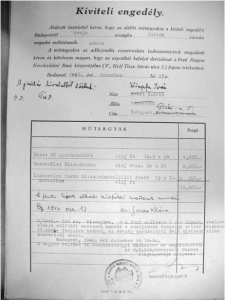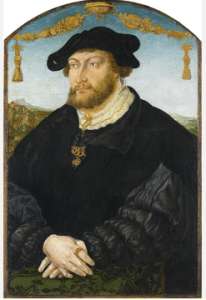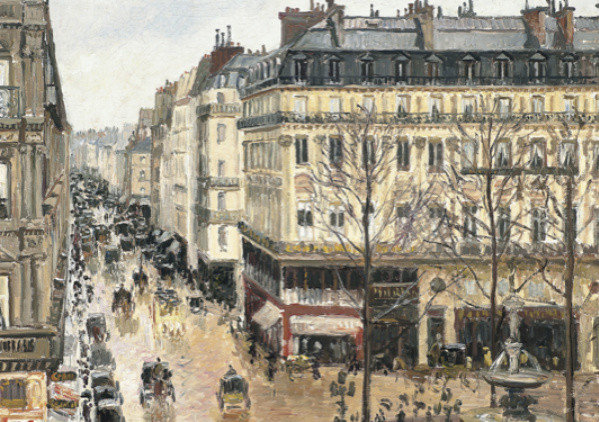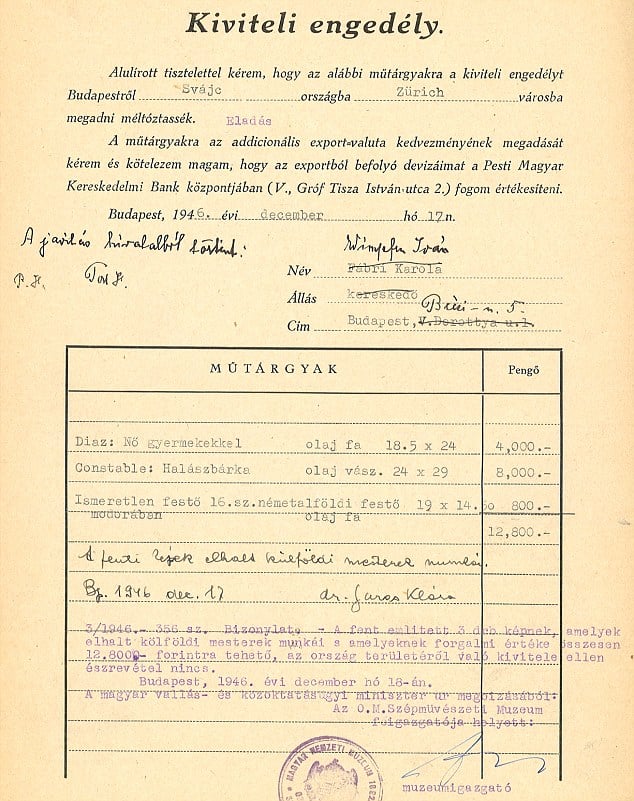After putting on hold its prior recommendation back in March of this year, the United Kingdom Spoliation Advisory Panel has recommended that the Tate Gallery in London should return Beaching a Boat, Brighton by John Constable to heirs of Budapest-based (and Jewish) Baron Ferenc Hatvany. The Art Newspaper reports that the Spoliation Panel concluded that the 1946 export license at issue in the springtime uncertainty (located from the Budapest Museum of Fine Arts) was insufficient to overcome the conclusion that title to the looted painting had not passed lawfully.
Restitution of Constable Painting at the Tate Moves Ahead Again
Topics: John Constable, Soviet, Budapest, Worcestershire, Hungary, London, The Art Newspaper, Beaching a Boat Brighton, Nazi-looted art, Red Army, Mrs P.M. Rainsford, Broadway Art Gallery, Budapest Museum of Fine Arts, Restitution, World War II, Baron Ferenc Hatvany, Tate Gallery, Museums, United Kingdom Spoliation Advisory Panel
Staatsgalerie Stuttgart Restitutes Wertinger Painting to Rosenbaum and Rosenberg Heirs, Citing Importance of Blocked Accounts That Also Support Guelph Treasure Claim
The Staatsgalerie Stuttgart has agreed to return Bildnis Pfalzgraf Johann III (Portrait of Elector-Palatine Johann III), ca. 1526, by Hans Wertinger to the heirs of the art dealers Saemy Rosenberg and Isaak Rosenbaum, the owners of the art dealer firm I. Rosenbaum in Frankfurt. Rosenbaum and Rosenberg sold the Wertinger in 1936, but the proceeds were paid into a Nazi-blocked account. The work eventually ended up with collector Heinrich Scheufelen in 1948.
Topics: Stefan Koldehoff, Joint Declaration, Nazi-looted art, Baden-Württemberg, Washington Principles on Nazi-Looted Art, Heinrich Scheufelen, Die Bilder Sind Unter Uns, SPK, Portrait of Elector-Palatine Johann III, Stiftung Preussischer Kulturbesitz, Nazi terror, Isaak Rosenbaum, Deutschlandfunk, Restitution, coerced sale, World War II, Staatsgalerie Stuttgart, Saemy Rosenberg, Jürgen Walter, Museums, forced sale, Zacharias Hackenbroch, Bildnis Pfalzgraf Johann III, Welfenschatz, The Pictures Are Under Us, I. Rosenbaum, Frankfurt
Munich Court Requests Psychological Opinion Concerning Gurlitt’s Competence to Make Will
Even as we creep up on the anniversary of the theatrical announcement of an agreement between Bavaria, Germany, and the Kunstmuseum Bern concerning the bequest of Cornelius Gurlitt, the court challenge by Gurlitt’s family is by no means over. News came this week that the Munich court overseeing the appeal of the initial denial of the will challenge has requested an expert opinion concerning Gurlitt’s psychological state.
Topics: Cornelius Gurlitt, Gurlitt Task Force, Nazi-looted art, Gurlitt Collection, Amtsgericht, Oberlandesgericht, Munich, Restitution, World War II, beschlagnahmte Kunst, Kunstmuseum Bern, Raubkunst
U.S. Museums and Looted Art—Is it Whether you Win or How you Play?
A recent report by the World Jewish Restitution Organization (WJRO) has made strong criticisms of American museums with respect to their handling of Nazi-looted art claims. In particular, the report criticizes the assertion of timeliness defenses such as statutes of limitations. The report focuses in particular on cases involving the Museum of Fine Arts, Boston, the Norton Simon Museum in Pasadena, the Toledo Museum of Art, and the Fred Jones, Jr. Museum at the University of Oklahoma. There is no state control over the vast proportion of art in America the way there is in most European countries, and thus, no possibility of singular, nationalized approaches. In response to the report, some of the museums mentioned have defended their strategies, though in some cases the players are talking past each other. What is undeniable is that whether as a function of the nature of U.S. museums (largely private, rather than public), it is hard to say there is a coordinated approach to the issue, good or bad. The report is lengthy and detailed, and well worth a read in depth that space here does not permit. In some ways, the question it poses boils down to this: is determining the historical truth the obligation of everyone involved or is there some room to prevail without addressing the larger issues?
Topics: Toledo Museum of Art, Street Scene in Tahiti, Léone Meyer’s, American Association of Museums, Two Nudes, La bérgère, AAMD Task Force on the Spoliation of Art during th, Thyssen-Bornemisza Collection, Rue St. Honoré après-midi êffet de pluie, University of Oklahoma, Cassirer, Nazi-looted art, Washington Conference on Holocaust Era Assets, Fred Jones Jr. Museum, Washington Principles on Nazi-Confiscated Art, World Jewish Restitution Organization, WJRO, Association of Art Museum Directors, Restitution, American Alliance of Museums AAM, World War II, Paul Gaugin, Camille Pissarro, Oskar Kokoschka, Museums, Museum of Fine Arts Boston, AAMD, Norton Simon Museum in Pasadena
Cassirer and the State of Restitution—Takeaways and Next Steps
I’ve been talking quite a bit to friends, colleagues and clients about the impact of last week’s decision in the Cassirer v. Thyssen Bornemisza case. The New York Times had a follow up article yesterday which was an interesting treatment of the various themes at work in the case and in restitution cases in the United States generally these days. In fact, I think the effect is mostly limited, except to the extent that the decision assumes and treats as uncontroversial important principles about sales under duress and is a case that resolved title under the Foreign Sovereign Immunities Act (FSIA). As we predicted, the Times article makes clear that the museum has absolutely no intention of giving the painting back, but did float the idea of some recognition of the historical circumstances, which is progress (certainly compared to other instances in which obvious circumstances of duress are denied).
Topics: Lilly Cassirer Neubauer, Terezin Declaration, Thyssen-Bornemisza Collection, Rue St. Honoré après-midi êffet de pluie, Jacques Goudstikker, California Code of Civil Procedure § 354.3, Nazi-looted art, Foreign Sovereign Immunities Act, Washington Conference Principles, Bakalar v. Vavra, Fritz Grünbaum, FSIA, adverse possession, expropriation exception”, Restitution, Marei Von Saher, sovereign immunity, Egon Schiele, Jakob Schweidwimmer, World War II, Foreign Sovereign Immunities, Restatement (Second) of Conflict of Laws § 222, Altmann v. Republic of Austria, Camille Pissarro, foreign affairs doctrine, Ninth Circuit Court of Appeals, Museums, Baron Hans-Heinrich Thyssen- Bornemisza, 28 U.S.C. § 1605
Foreign Cultural Exchange Jurisdictional Clarification Act Returns
The U.S. House of Representatives passed yesterday H.R. 889, the Foreign Cultural Exchange Jurisdictional Clarification Act for the third time in four years. Identical bills passed the house in early 2012 and again last year but failed to win passage in the Senate and signature by the President, thus expiring without becoming a law (and remaining just a bill sitting on Capitol Hill). Will it become law? Probably not, and after a little reflection and evolution, that’s probably for the best.
Topics: U.S. House of Representatives, Foreign Cultural Exchange Jurisdictional Clarifica, Second Hickenlooper Amendment, Russia, Herrick Feinstein, Nazi-looted art, Konowaloff, Stiftung Preussischer Kulturbesitz, Association of Art Museum Directors, Restitution, World War II, Foreign Sovereign Immunities, act of state doctrine, Senate, Altmann v. Republic of Austria, Capitol Hill, Immunity from Seizure Act, Chabad, Federal Republic of Germany, 28 U.S.C. § 1605, Welfenschatz, Foreign Cultural Exchange Jurisdictional Immunity, Mari-Claudia Jiménez, Cuba
District Court Dismisses Cassirer Claim for Pissarro against Thyssen Bornemisza Collection by Applying Spanish Law of Adverse Possession
One of the longest running art restitution litigations in the United States has been dismissed for a second time, with another appeal likely to follow. The heirs of Lilly Cassirer Neubauer have been pursuing the return of Camille Pissarro’s Rue St. Honoré, après-midi, êffet de pluie from the Thyssen-Bornemisza Collection in Madrid for more than ten years, but on June 4, 2015 the U.S. District Court in Los Angeles ruled that the Spanish museum has acquired full title to the painting by adverse possession. The key aspect of the decision is the court’s resolution of the choice of law question, namely, should California law or Spanish law apply to the question of who owns the painting? After a lengthy analysis the court determined that Spanish law applies, and that the museum has possessed the painting long enough to have become the owner regardless of the fact that it was sold under duress. So now a case that has already been to the Ninth Circuit Court of Appeals twice will almost certainly head back a third time. The court concluded its decision by appealing to the parties to “pause, reflect, and consider whether it would be appropriate to work towards a mutually-agreeable resolution of this action, in light of Spain’s acceptance of the Washington Conference Principles and the Terezin Declaration, and, specifically, its commitment to achieve “just and fair solutions” for victims of Nazi persecution.” But it is hard to see why that would happen. Notwithstanding the dictates of the Washington Principles, the Collection has been quite content to resist the claim. Now that it has won, it is hard to imagine it suddenly taking a different view.
Topics: Lilly Cassirer Neubauer, Terezin Declaration, Thyssen-Bornemisza Collection, Rue St. Honoré après-midi êffet de pluie, Jacques Goudstikker, California Code of Civil Procedure § 354.3, Nazi-looted art, Foreign Sovereign Immunities Act, Washington Conference Principles, FSIA, adverse possession, expropriation exception”, Restitution, Marei Von Saher, sovereign immunity, Jakob Schweidwimmer, World War II, Foreign Sovereign Immunities, Restatement (Second) of Conflict of Laws § 222, Altmann v. Republic of Austria, Camille Pissarro, foreign affairs doctrine, Ninth Circuit Court of Appeals, Museums, Baron Hans-Heinrich Thyssen- Bornemisza, 28 U.S.C. § 1605, Welfenschatz
Two Works Found With Gurlitt Cleared for Immediate Restitution, Hundreds More Still in Limbo
After months of start/stop and hurry up and wait, the Munich court with jurisdiction over the Gurlitt collection has cleared two paintings for restitution to the heirs of their original owners. David Toren and the Rosenberg family will receive Two Riders on the Beach (Ritter am Strand) by Max Liebermann and Seated Woman by Henri Matisse, respectively. This will also result in the resolution of the only lawsuit to date filed over the Gurlitt case (pending in Washington, DC). Toren and the Rosenbergs are to be congratulated for their perseverance, as should their representatives (again, respectively) August Matteis and Christopher Marinello—particularly after some eleventh-hour victim-blaming.
Topics: Gurlitt Task Force, Nazi-looted art, Gurlitt Collection, Two Riders on the Beach, August Mattheis and Christopher Marinello, Munich, Rosenbergs, Gurlitt, Restitution, David Toren, World War II, W Wall Street Journal, Ritter am Strand
Gurlitt Cousin Appeals Dismissal of Will Contest
Uta Werner has appealed the adverse decision of the Munich court last month with respect to her challenge to Cornelius Gurlitt’s will. Werner, the cousin of Cornelius Gurlitt, argued that the will written by Gurlitt that named the Kunstmuseum Bern as his heir (and thus to his art collection). The Munich court previously upheld the will, making the Bern museum the sole heir to Gurlitt in all respects, including not only the trove found in Munich but some 200 (arguably more significant) works found in his Salzburg, Austria home.
Topics: Cornelius Gurlitt, Uta Werner, Gurlitt Task Force, Nazi-looted art, Gurlitt Collection, Restitution, World War II, Kunstmuseum Bern, Raubkunst
Postwar Export Permit Apparently At the Center of Shift in Tate Restitution Dispute
We reported recently on the possible change in the anticipated restitution of a John Constable painting in the Tate Gallery, London. After the United Kingdom Spoliation Advisory Panel recommended that Beaching a Boat, Brighton be returned to the heirs of Baron Ferenc Hatvany, the Tate issued a statement that it had received new information and was reviewing the recommendation.
Topics: John Constable, Budapest, The Daily Mail, Karola Fabri, London, Baron von Herzog, Beaching a Boat Brighton, Nazi-looted art, Budapest Museum of Fine Arts, Restitution, World War II, Baron Ferenc Hatvany, Tate Gallery, Museums, Zürich, United Kingdom Spoliation Advisory Panel






